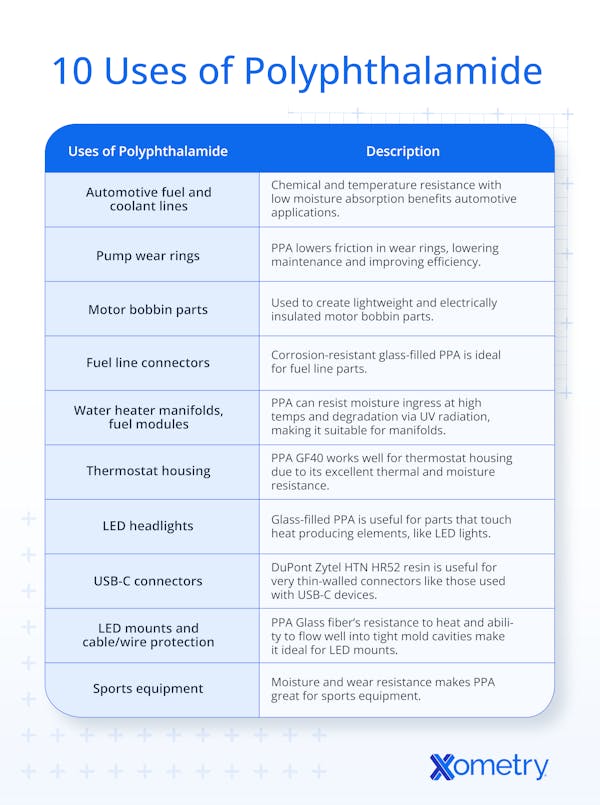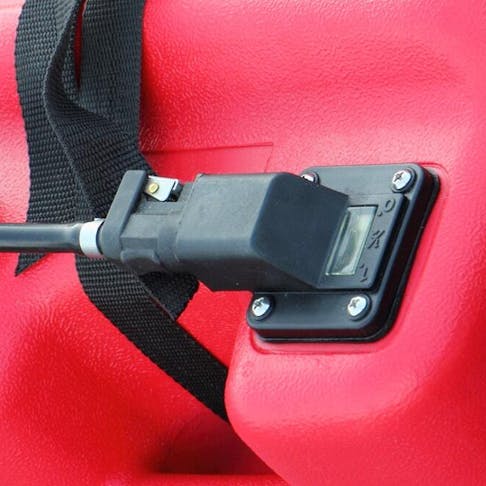Polyphthalamide (PPA) is a semi-crystalline thermoplastic that sees widespread use in the automotive, aerospace, and electrical industries. Its moisture and temperature resistance make it an ideal material for these sectors.
Polyphthalamide flows well in molten form making it ideal for injection-molded components with small features and thin sidewalls. This article will describe 10 uses of Polyphthalamide – as summarized in the table below – and give reasons why this material works so well.

1. Automotive Include Fuel and Coolant Lines
Automotive fuel lines and coolant lines are the arteries of any combustion engine. However, they carry corrosive chemicals and function in hot environments. PPA’s chemical resistance limits fuel, moisture, and gas permeation. Along the way, they confer another key advantage: weight savings. Automotive designers, who continuously strive for improved efficiency and fewer emissions, will appreciate this side-effect.
2. Pump Wear Rings
Various pumps are designed to transport fluids ranging from water to hydrocarbons. Oftentimes, they run under high pressure, high temperatures, and highly corrosive conditions. Pumps in challenging applications are usually made from corrosion-resistant stainless steel or are lined internally with corrosion-resistant coatings. However, their rotating parts must be sealed to prevent fluids from leaking. These rings must be flexible so they can get compressed against rotating parts to create a fluid-tight seal. They are also designed to be replaced as the continuous contact with moving parts creates significant wear. PPA wear rings have low friction coefficients. They improve pump efficiency by creating less resistance to motion extending maintenance intervals and reducing vibration. The creep resistance of PPA means that the seal rings will not relax over time.
3. Motor Bobbin Parts
A motor bobbin is a component over which the copper coils of an electric motor are wrapped. These bobbins were traditionally made from metal, so they added a lot of weight to electric motors. However, electric motors with PPA motor bobbins are significantly lighter. The reduced mass of electric motors has a significant effect on the efficiency and range of electric vehicles. PPA flows well in injection molds, so bobbin wall thickness is not hard to optimize. PPA material is also an excellent electrical insulator.
4. Fuel Line Connectors
Fuel line connectors are used to connect flexible fuel lines to equipment like fuel pumps and fuel filters. These couplings need to be able to survive the corrosive fuel while also resisting the high temperatures in which they operate. PPA Glass fiber-filled PPA GF35 or PPA GF33 have the necessary chemical and thermal resistance.
5. Water Heater Manifolds, Fuel Modules
Solar water heaters work by running water through a series of pipes that absorb heat from the sun. They reduce loads on electrical or gas-powered water heaters and therefore save energy. The manifold is the component that connects the pipes to the tank. It must resist moisture ingress at relatively high temperatures while also being able to resist degradation caused by UV radiation. PPA plastic is ideal for this application.
The fuel module is an automotive component that controls the extraction and metering of fuel from the fuel tank. In short, it regulates the fuel flow rate. The fuel module needs to resist corrosive chemicals, so PPA’s chemical resistance makes it ideal.
6. Thermostat Housing
A vehicle’s thermostat is usually situated on the engine block and also functions as the engine coolant exit. The thermostat prevents coolant from flowing until the engine itself has warmed up. Once the coolant is moving, the thermostat helps to regulate the engine’s temperature. Because the thermostat housing is located on the hot engine block and is exposed to hot coolant, it needs to have excellent thermal and moisture resistance. PPA Glass fiber like PPA GF40 serves exactly that purpose.
7. LED Headlights
All modern vehicles use LED headlamps due to their efficiency, longevity, and luminosity. An LED headlamp consists of a lamp housing, lamp bezel, module frame, and reflector. The lamp module frame comes into direct contact with the LED lights so it needs to be heat resistant. It’s also good for the module to be lightweight. Glass-filled PPA resin has excellent thermal resistance and mold flowability.
8. USB-C Connectors
USB-C connectors are fast becoming the standard data and power ports for mobile phones and laptops. By design, USB-C connectors are very small and feature walls as thin as 0.18 mm. In order to injection-mold parts with such thin walls, a specialized PPA is used, specifically DuPont Zytel HTN HR52. This material was specifically formulated to improve PPA’s laudable flowability even further.
9. LED Mounts and Cable/Wire Protection
LED mounts are just what they sound like; the LEDs and associated circuit boards get affixed to a molded mounting unit so they can be properly fitted in devices or lighting sconces. While LED lights generate far less heat than incandescent bulbs, they still warm up. The LED mounts need to be able to withstand this heat without degrading. PPA Glass fiber is ideal for this application because it is resistant to heat. And because PPA melt flows so well, the mounts can be designed as very thin parts that use a minimum of material. These features also make PPA ideal for cable or wire protective fittings and couplings.
10. Sports Equipment
Sports equipment is often exposed to moisture. Track equipment, cycling gear, and watersports accoutrements, among others, routinely get wet. As such, equipment must be made of a material that resists moisture ingress even during long-term outdoor use. PPA is especially well suited as it is both water-resistant and does not wear down quickly. Water-based sporting equipment is often made of PPA.
Common FAQs About Polyphthalamide
What is the Importance of Using Polyphthalamide?
PPA polymer is an advanced semi-crystalline thermoplastic intended for applications that require temperature resistance, injection-molding flowability, chemical resistance, and mechanical strength. Polyphthalamide fuel systems are common due to their low fuel or gas permeation properties. The PPA properties listed in this article lay plain how useful it is in hot and moisture-heavy applications.
What Are the Risks of Using Polyphthalamide?
Polyphthalamide, like most engineering thermoplastics, is non-toxic when used in its intended applications. If burnt, PPA can release toxic combustion products that are harmful to human health. PPA is not typically used in medical and food applications and therefore does not pose a health risk to normal consumers if used as intended.
When Was the First Time Polyphthalamide was Used?
Polyamides were first developed in 1935 by DuPont. These basic polyamides like Nylon 6.6 were precursors to further development that ultimately resulted in the synthesis of Polyphthalamide (PPA).
Which Products Contains the Most Polyphthalamide?
Products in the automotive, aerospace, and electrical sectors use PPA extensively. Its unique combination of moisture resistance, high-temperature resilience, mechanical strength, low permeability, and rigidity makes it an outstanding material.
Is Using a Machine Necessary When Using Polyphthalamide?
Specific machinery is necessary when processing Polyphthalamide. PPA can only be formed using melt processing techniques or through CNC machining.
Summary
This article provided a look at the versatility of Polyphthalamide and summarized 10 important uses of the material.
Xometry offers injection molding services for all of your prototyping and production needs. Visit our website to learn more and to request a free, no-obligation quote using our Instant Quote Engine.
Disclaimer
The content appearing on this webpage is for informational purposes only. Xometry makes no representation or warranty of any kind, be it expressed or implied, as to the accuracy, completeness, or validity of the information. Any performance parameters, geometric tolerances, specific design features, quality and types of materials, or processes should not be inferred to represent what will be delivered by third-party suppliers or manufacturers through Xometry’s network. Buyers seeking quotes for parts are responsible for defining the specific requirements for those parts. Please refer to our terms and conditions for more information.

